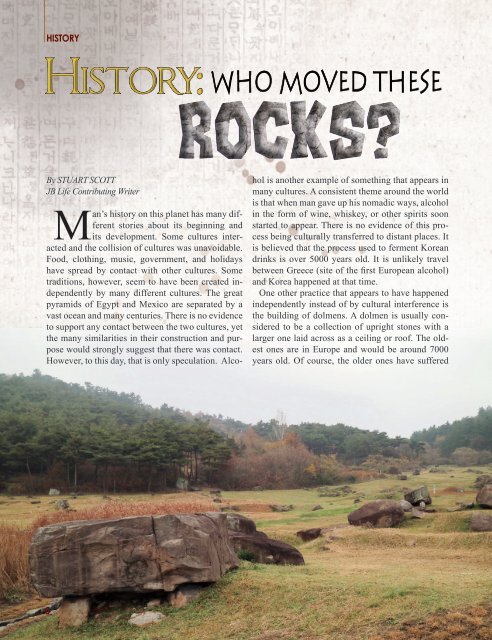JB Life January 2017
Volume 5 (January 2017) of JB Life, a publication of the Jeollabuk-do Center for International Affairs. Enjoy!
Volume 5 (January 2017) of JB Life, a publication of the Jeollabuk-do Center for International Affairs. Enjoy!
You also want an ePaper? Increase the reach of your titles
YUMPU automatically turns print PDFs into web optimized ePapers that Google loves.
HISTORY<br />
By STUART SCOTT<br />
<strong>JB</strong> <strong>Life</strong> Contributing Writer<br />
Man’s history on this planet has many different<br />
stories about its beginning and<br />
its development. Some cultures interacted<br />
and the collision of cultures was unavoidable.<br />
Food, clothing, music, government, and holidays<br />
have spread by contact with other cultures. Some<br />
traditions, however, seem to have been created independently<br />
by many different cultures. The great<br />
pyramids of Egypt and Mexico are separated by a<br />
vast ocean and many centuries. There is no evidence<br />
to support any contact between the two cultures, yet<br />
the many similarities in their construction and purpose<br />
would strongly suggest that there was contact.<br />
However, to this day, that is only speculation. Alcohol<br />
is another example of something that appears in<br />
many cultures. A consistent theme around the world<br />
is that when man gave up his nomadic ways, alcohol<br />
in the form of wine, whiskey, or other spirits soon<br />
started to appear. There is no evidence of this process<br />
being culturally transferred to distant places. It<br />
is believed that the process used to ferment Korean<br />
drinks is over 5000 years old. It is unlikely travel<br />
between Greece (site of the first European alcohol)<br />
and Korea happened at that time.<br />
One other practice that appears to have happened<br />
independently instead of by cultural interference is<br />
the building of dolmens. A dolmen is usually considered<br />
to be a collection of upright stones with a<br />
larger one laid across as a ceiling or roof. The oldest<br />
ones are in Europe and would be around 7000<br />
years old. Of course, the older ones have suffered<br />
the most weathering over the years. We cannot be<br />
sure who built these first Dolmens, so it impossible<br />
to prove why they built them. It is generally<br />
conceded that they were some sort of a burial<br />
chamber, but this is only speculation. Burial items<br />
found nearby may or may not have been placed at<br />
the time of building. It is possible that they were<br />
changed to burial plots sometime after their construction.<br />
We don’t know. Russian dolmens, for<br />
example, are believed to be vaults for storing their<br />
gold and other precious metals. The people in this<br />
area were miners and eventually the local population<br />
was conquered and enslaved to steal their<br />
treasures.<br />
The size of these dolmens has led to many stories<br />
about their creation. One of the largest ones<br />
is in Spain and is 25 meters long and weighs over<br />
180 metric tons. It is seriously doubted by some<br />
that the engineering technology required to build<br />
such a structure was available at the time. Perhaps<br />
we had visitors from another planet to help build<br />
them. Perhaps some Godlike creature built them.<br />
Again, even though there were many human skeletons<br />
found inside, there is no evidence to prove<br />
that they were placed there at the time of construction<br />
or that it was built earlier with this purpose in<br />
mind.<br />
Another large dolmen is in Ireland. If the construction<br />
date of 4000 to 3000 BC is accurate, then<br />
it would have been built by the earliest farmers to<br />
move to Ireland. How could these early settlers<br />
have moved the 100 metric tons that these stones<br />
represent?<br />
Of course, finally we will look at the dolmens in<br />
Korea. If one includes North Korea, the peninsula<br />
has the largest number of dolmens in the world (an<br />
estimated 35,000). “Dolmen” in Korean is “goindol”<br />
(고안돌). This means “supported stone.” Remarkably,<br />
the building of these structures is mostly<br />
limited to the Korean peninsula in East Asia.<br />
Some are in China and a few much larger ones<br />
also exist off the peninsula. As Korea, too, was<br />
becoming an agricultural society at this time, it<br />
is hard to imagine the people having the time or<br />
ability to build them.<br />
One of the three main locations of Korean dolmen<br />
is right here in North Jeolla province. This<br />
group of dolmen is the largest in Korea. They are<br />
mostly in the village of Maesan, near Gochang.<br />
Sixteen-hundred plus dolmens have been located<br />
here, with over 400 of them designated as World<br />
Heritage sites. The ones in Gochang county are the<br />
largest and most diversified in Korea. Unlike dolmens<br />
around the world, there is evidence to show<br />
the dolmens in Korea were indeed grave sites of<br />
the important or rich citizens. Some in South Jeolla<br />
province actually show the year they were built<br />
and the identity of those buried within.<br />
Also, almost all Korean dolmen are covered.<br />
This would be consistent with the theory of a<br />
burial chamber. The absence of a roof on many<br />
dolmen outside of Korea raises certain questions<br />
about their use.<br />
Burial chambers, early art, protection from wild<br />
animals, or built by visitors from other planets are<br />
possible explanations given for their construction.<br />
You can decide which you feel is correct. Whichever<br />
explanation you choose, a trip to Maesen to<br />
see these ancient rocks is a must, before you leave<br />
Korea.<br />
For more information on the Gochang<br />
Dolmens, check out the TOUR section on<br />
Page 12!<br />
LEFT: A line of dolmens in Gochang.<br />
[Photo by Renee McMillan]<br />
6<br />
Jeonbuk <strong>Life</strong> 7







